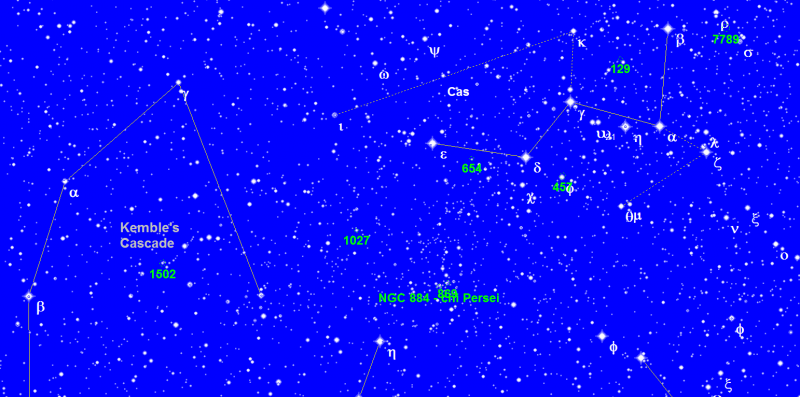2015 November 26
A celestial waterfall for binoculars
Some constellations are easy to recognise, some are more difficult and some are almost invisible and it’s one of the invisible variety that this article is about. But it’s worth persevering in the search as it contains a beautiful little asterism and one ideal for binoculars. The constellation in question is Camelopardalis (the Giraffe) and the asterism is Kemble’s Cascade.
Camelopardalis lies roughly between Cassiopeia and Auriga and north of Perseus. When the alpha star in a constellation is only magnitude 4.3 you know it is never going to be a “show your neighbour” type of object, but if you have a reasonably dark sky site and a vivid imagination you may just make out the shape of a celestial giraffe.
Kemble’s Cascade was named by the great US amateur astronomer Walter Scott Houston after it was pointed out to him by Father Lucian Kemble, an amateur astronomer who was also a Franciscan friar. Scotty, as Houston was always known, wrote about the asterism in his Sky and Telescope column in 1980. The asterism consists of an almost straight line of about 20 coloured stars ranging from 10th to 5th magnitude covering around 2.5 degrees and finishing with the open cluster NGC 1502 – the splash at the end of the waterfall. NGC 1502 is not spectacular in binoculars , appearing slightly triangular in shape, but it does represent the waterfall splash rather well.
So how to locate it? The cluster itself lies at RA 4h 7.7min and Dec +62deg 20arcmin. It has a magnitude of 5.7 and diameter of around 12arcmin. It stands out well in small telescopes (say 75 to 100mm) but to appreciate the complete asterism with its final splash a pair of 7×50 or 10×50 binoculars are the ideal instrument. Starting with the familiar W shape of Cassiopeia (see chart below) continue a line from beta Cass through epsilon – the 2 stars at the top of the W shape – for a distance equal to the distance between these 2 stars and this will take you straight to the cascade. As you will also see from the star chart, the bottom 2 stars, alpha and delta Cass, also point to the asterism, so take your choice.
| The British Astronomical Association supports amateur astronomers around the UK and the rest of the world. Find out more about the BAA or join us. |
